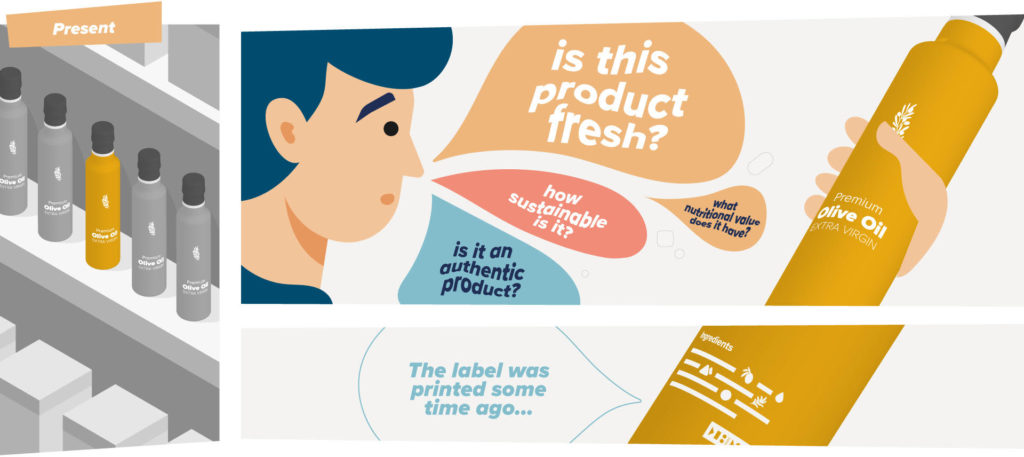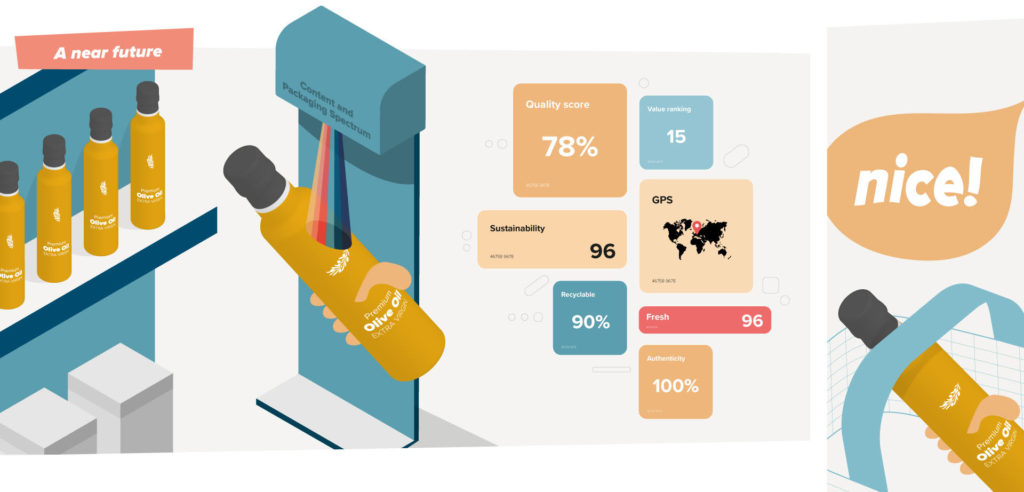In order to build a sustainable relationship of trust, quality will need to be proven through immediate and individual ‘direct experience’, not promised through labels or marketing.
Learn how emerging yet available technologies such as Optical Emission Spectroscopy (OES), image recognition, HF-RFID, and down the road mobile enabled smell or DNA, will combine to better inform consumers / shoppers at the point of purchase.
Decision Drivers:
Price – Trust
Purpose – Health – Experience
Sustainability – Social Media – Quality
There are many input sources that every average shopper needs to balance each time they pick up a product in store or online with a click. The shopper relies on information printed on the label, and references form their social circle or provided somewhere online. Balancing is a tiresome process, and usually the tired-out shopper decides to proceed primarily based on price.
Looking at a plastic crate of strawberries, you can trust the label printed days earlier, telling you where it is supposed to have come from and what to expect with regards to taste, nutrition, and sustainability. Ever thought about asking some of these questions to the crate and the strawberries directly, in store?
Mobile First
An increasing amount of commoditised technology is combined and packed into consumer devices like our smartphones, used by 3.5 billion people worldwide. We usually mostly speak about functions such as sending messages, taking pictures, watching movie clips, capturing audio/video, paying at point of sale, measuring our steps or heart rates, connecting to fitness apps, and finding the shortest way between two spots on a map, to name a few.
The latest addition to these impressive technologies can be the Optical Emission Spectroscopy (OES).
What Can the New Kid on the Block Bring to the Table?
I first learned about OES during The Consumer Goods Forum’s (CGF) spring 2019 SpringBoard event in Barcelona. Our SpringBoard co-host TeakOrigin explained the vision: imagine a shopper’s smartphone connecting to a mobile OES unit, and analysing the content and packaging of Spanish olive oil bought on the way to the ROC-35 meeting site the same morning. There is no need to open the bottle, just hold the handheld device next to the bottle, enabling the spectrum read to be sent over the phone to a database where software – and databases built over time – separates it into signals, revealing characteristics about both packaging and content.
The spectrum could identify the content as olive oil and could offer a potential recycling value of the packaging components used to produce the plastic bottle. Had the producer uploaded their own spectrum lecture directly from the bottler, the software could have clearly matched content with packaging type and thus identify the product and producer.
In the traditional approach, the information displayed on the label of a product never changes, while the content does undergo changes, as does the packaging over time. You can choose to trust information provided on a label, or potentially choose to pull out your own devices to check important parameters like ‘freshness’ for yourself at any given time. The value of ‘live’ versus ‘static’ information is clear, especially for the food shopper.
|
Counterfeit Protection: The product’s own optical spectrum turns out to be a powerful unique identifier of the product type, combining information on content (like acids and sugar) and packaging components used to contain it. It turns out that the combination creating this kind of digital fingerprint is quite easy, unique, and close to impossible to cheat. |
Converting a Label into Something Bigger
Labels are great. Just as our eyes can identify a product looking at it from different angles, so can a camera, coupled with the right software and databases or neural networks. It becomes increasingly common to convert any product label with imagery, artwork and words into a single unique visual fingerprint. A simple picture of the label can help identify the product type, and combined with image recognition, can double-confirm the product and brand by reading the text.
To this combination, now add GPS data that you can make readily available. The GPS coordinates and picture combined can check if the product was scanned in an expected location/region/country, or area within your stores. This can be achieved using any of the available inhouse GPS/indoor positioning systems. Additionally, you could convert the address of a customer into GPS coordinates and check if your product was successfully shipped to their home, with their agreement, once they take a picture of the label on the kitchen table, and as part of the value chain integrity to support consumer trust. A new choice for improved services is thus created.
In a not too distant future, some smartphones might also read out an economic HF-RFID chip hidden in a minuscule 4mm filament in a corner behind the adhesive label, and immediately produce any form and format of an embedded, free and universal unique serial number. The serial number allows the manufacturer to determine correspondences like production date, time, lot number, production site, and machine.
|
The combined value of a universally unique serial code, camera picture of the product label (including symbols) and connected GPS data, can allow for a quick cross-check if an individual product was supposed to be on sale, in that geography and at that specific moment in time. |
Build Your Tech-Combinations
What becomes evident is the simple power of combining readings from different sensors, allowing to reinforce results through cross-checks. The ‘sensor fusion’ allows for combinations of hitherto unforeseen data available, delivering timely insights expected by shoppers. All of this can be made available through shrinking (though still expensive) devices in the consumer’s hand, or even better, provided by stores themselves and thus enabling their customers to check and inform themselves.
These technologies have the capacity to enable independence of apps to retail and supplier combined with standards. The producer could cross-check their own measured OES value at the production site with the content spectrograph shared by the consumer, to ensure that the quality, safety and standards of the product about to be consumed are still good. The producer could confirm, with a high level of probability, that it is really the company’s original product that the consumer is handling.
|
At least 2 out of 3 sensors need to supply information about the product to reach a higher level of authentication. Examples: image combined with packaging spectrum, image combined with RFID, spectrum combined with RFID serial, or all three with more iterations possible. |
Our industry today glues the familiar 1D bar code to products to serve laser-based systems, successfully used for decades in warehouses and notoriously beeping at retail checkouts. Cameras built into the simplest smartphone or POS systems could potentially read much more than black and white stripes, and you can choose to silence the beeping. The software layer and ubiquitous internet access make this possible. An additional opportunity is that future invoices produced at a POS can include more insights, and as such, sustainable decisions can be made in real time and with lasting effects.
For example, OES technology has the potential to quickly enable consumers to calculate a product’s price, adding or deducting the remaining value of the packaging they bought with the product, after consumption.
|
Buying a comparable product with a more sustainable packaging composition could pay off at the point of sale as the potential example below suggests: ● 100% authentication (image recognition + content spectrum) ● Freshness and ready for consumption: compliant values read ● 10.00 USD (sale) ● -0.70 sustainability pledge (packaging recycle value via packaging spectrum) ● 9.30 USD = total amount payable |
The same OES technology that allows you to see through the wall of an olive oil bottle without opening it, can now inform the consumer if the product they are about to purchase is still fit for consumption, and as an optional feature, inform the consumer of the return value of the plastic bottle, should they choose to recycle it.
This recycling feature mentioned above is powerful in its own right, as the consumer will be able to assess the price impact at the cashiers till for sustainable versus less sustainable packaging and freshness options directly from their own devices. The consumer / shopper is now empowered to strike the balance between price, purpose, experience, trust, health, and sustainability, and can make better self-informed and self-empowered purchase decisions.
|
This combination of different technologies is fully in line with the CGF End-to-End Value Chain guideline of offering more and better choices to industry, and the consumer. |
Choice – Fit for Purpose
By enabling the above technology, the shopper is given the choice to simply trust information printed on the label of a product, or enhance and experience for themselves more information that they can trust. Shoppers using their preferred applications and connecting to online/offline databases will in the future able to better assess the ‘fit for purpose’ and environmental impact of products they choose to purchase.
In the future, perhaps the sense of smell can be incorporated into phones too, which next to powerful cameras, detecting aerosols and other agents could provide valuable insights on quality, safety, and if the product is still consumable. DNA tests are also a potential opportunity to supplement consumer information needs, although not yet available in a customised phone size kit for an easy shopping experience.
The ‘real time information’ opportunity has always existed before our very own eyes, only invisible. Truth is not about believing others or information claimed elsewhere, it is about marketing influence combined with direct experience at the point of purchase.
Isn’t it about time to reconsider certain things and provide more and better choices for consumers?
This blog was written and contributed by:
Ruediger Hagedorn
Director, End-to-End Value Chain
The Consumer Goods Forum



